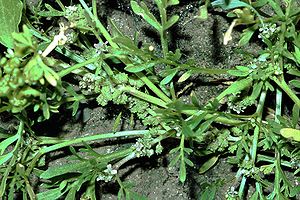Lying crow's foot
| Lying crow's foot | ||||||||||||
|---|---|---|---|---|---|---|---|---|---|---|---|---|

Prostrate crow's foot ( Lepidium coronopus ) |
||||||||||||
| Systematics | ||||||||||||
|
||||||||||||
| Scientific name | ||||||||||||
| Lepidium coronopus | ||||||||||||
| ( L. ) Al-Shehbaz |
The prostrate crow's foot ( Lepidium coronopus (L.) Al-Shehbaz , syn .: Lepidium squamatum Forssk. , Cochlearia coronopus L. , Coronopus procumbens Gilib. , Coronopus ruellii All. , Senebiera coronopus (L.) Poir. , Coronopus squamatus (Forssk .) Ash. ), Also called warty crow's foot , is a species of the genus Kressen ( Lepidium ) in the cruciferous family (Brassicaceae). It is quite rare in Central Europe .
description
This annual herbaceous plant reaches heights of about 5 to 30 cm. The stem grows prostrate or slightly ascending, is very branchy and bare from the bottom. The foliage leaves are deeply divided into pinnately split leaves .
The flowers sit in ball-shaped, racemose inflorescences . The pedicels are shorter than the flowers and fruits. The four petals are only about 1 to 2 mm long, white, and a little longer than the sepals. The flower has six stamens . This species mainly flowers from June to August.
The pods are almost kidney-shaped, compressed, reticulated and wrinkled with spikes, 3.5 to 4 mm wide and radially striped at the edge. They are crowned with a conical stylus and do not crack open when ripe. The seeds are 2 to 2.5 mm in length.
The species has chromosome number 2n = 32.
ecology
Both insect and self-pollination occur in this species.
The fruits are present in the months of July to November. It spreads by attaching it to the fur of animals or to the clothing of people, whereby the spikes on the fruits should be helpful.
Occurrence
General distribution
The prostrate crow's foot is native to Europe , West Asia, the Caucasus and North Africa. It is a neophyte in Macaronesia, South Africa, North America , Australia , New Zealand and Chile. It is a Mediterranean-sub-Mediterranean floral element . In Austria the species is rarely found in the Pannonian area and is endangered, in Switzerland it is also very rare.
Distribution in Germany
The low-lying crow's foot is only found scattered in Germany in the central area, otherwise it is seldom to very seldom to be found or is completely absent, especially in the mountainous areas.
Location requirements
The prostrate crow's foot grows in step plant communities . It prefers fresh, often somewhat salty, nitrogen-rich, heavy, mostly clayey loamy soils. In Central Europe it is a character species of the Poo-Coronopetum squamati from the association Polygonion avicularis.
Species protection
Endangerment in Germany: Category 3: endangered!
literature
- Henning Haeupler , Thomas Muer: picture atlas of the fern and flowering plants of Germany (= the fern and flowering plants of Germany. Volume 2). Published by the Federal Agency for Nature Conservation. Ulmer, Stuttgart 2000, ISBN 3-8001-3364-4 .
- Wolfgang Adler, Karl Oswald, Raimund Fischer: Excursion flora of Austria. Ed .: Manfred A. Fischer . Ulmer, Stuttgart / Vienna 1994, ISBN 3-8001-3461-6 .
- August Binz , Christian Heitz: School and excursion flora for Switzerland , Schwabe & Co. AG, Basel, 1986, ISBN 3-7965-0832-4
- Erich Oberdorfer : Plant-sociological excursion flora , Ulmer Verlag, Stuttgart, 1990, ISBN 3-8001-3454-3
- Christian August Friedrich Garcke : Illustrierte Flora , 1972, Paul Parey publishing house, ISBN 3-489-68034-0
Individual evidence
- ^ Lepidium coronopus in the Germplasm Resources Information Network (GRIN), USDA , ARS , National Genetic Resources Program. National Germplasm Resources Laboratory, Beltsville, Maryland.
- ↑ a b Erich Oberdorfer : Plant-sociological excursion flora for Germany and neighboring areas . 8th edition. Stuttgart, Verlag Eugen Ulmer, 2001. ISBN 3-8001-3131-5
- ↑ a b Lepidium in the Germplasm Resources Information Network (GRIN), USDA , ARS , National Genetic Resources Program. National Germplasm Resources Laboratory, Beltsville, Maryland. Retrieved July 28, 2017.
Web links
- Lying crow's foot. In: FloraWeb.de.
- Distribution map for Germany. In: Floraweb .
- Coronopus squamatus (Forssk.) Ash. In: Info Flora , the national data and information center for Swiss flora . Retrieved October 26, 2015.
- Distribution in the northern hemisphere according to: Eric Hultén , Magnus Fries: Atlas of North European vascular plants 1986, ISBN 3-87429-263-0
- Thomas Meyer: Data sheet with identification key and photos at Flora-de: Flora von Deutschland (old name of the website: Flowers in Swabia )
- Entry in Plants for a Future. (engl.)
- Characteristics


